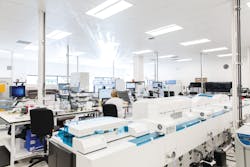The large volume of testing for SARS-CoV-2 has exposed process-flow bottlenecks in clinical labs. That is why labs should prepare for an expected onslaught of COVID-19, flu and other diagnostic testing demands by eliminating as many manual steps in workflows as possible, experts said.
Northwest Laboratory in Bellingham, WA, knows all about the bottlenecks that paper processes can cause. The independent lab processes between 10,000 and 12,000 molecular tests to detect SARS-CoV-2 per day, with specimens coming to the lab from 31 states. It has the capacity to process as many as 30,000 SARS-CoV-2 tests daily with its current equipment – 12 biosafety hoods, five primary high-throughput analyzers and several backup analyzers – and staffing.
The lab reengineered processes to get to that scale, particularly in the pre-analytical phase. For example, it installed a commercial web portal that allows consumers to self-register for a test and then print or download to their phone a requisition – which includes a barcode – to take to a specimen-collection site. Now specimens arrive at the lab already labeled with the patient’s name and unique barcode. Results are automatically available for patients and their providers through the portal, which is also integrated with the laboratory information system (LIS).
Northwest Laboratory is not alone. Paper processes exist at clinical labs in pre-analytical, analytical and post-analytical phases of testing as well as in billing processes.
“If you are still on paper, I think you will struggle. Labs need to focus on how they can increase their throughput,” said Philippe Flamant, Vice President of Solutions Engineering at ELLKAY, who adds that testing demand in 2021 is likely to be greater than in 2020 because of surveillance efforts associated with reopening businesses and schools. “You have more employers who want people to come back into the office. You have people who want to go back to work. You have students who want to go back to school,” he said.
Pre-analytical
Once of the biggest sources of bottlenecks is in the pre-analytical phase. As David Metrena, Vice President of Healthcare at LabVantage Solutions, explained, “We’re seeing increased reliance on paper or manual processes to accommodate nonstandard sources – when testing facilities don’t have established relationships with the labs where they are sending samples. A pop-up COVID-19 testing center in a school parking lot, for example, may not have the resources for electronic data capture at the time of sample collection, so a paper requisition joins the sample when it’s delivered to the lab. The lab then either manually enters the data, or perhaps scans it to convert it to electronic form.”
That’s exactly the situation at Northwest Laboratory, which has many new clients that will probably not be customers after the pandemic is over, making it financially untenable for Northwest Laboratory to build a bidirectional electronic interface between its LIS and the client’s electronic medical record. These clients also are unlikely to want to use the web-portal software, Test Directly, that Northwest Laboratory uses to automate specimen collection and testing processes.
In these cases, the paper requisition associated with each specimen is scanned into the LIS. Transcriptionists working from home pull up the scanned document and then add the patient’s demographic information into the appropriate fields in the LIS, allowing the lab staff to focus on testing. “We took the data entry out of the lab completely. We have one dedicated person who does quality checks for people doing data entry at home just to make sure we are not having data entry errors,” Jennifer Bull, Chief Operating Officer at Northwest Laboratory, said.
Despite those steps, paper requisitions can be “riddled with errors – missing ICD-10 codes or other billing information, incorrect or incomplete test orders, illegible writing, manual labels, etc. – causing an increase in specimen intake time to correct the orders and even jeopardizing patient safety due to incomplete information, or mislabeled or mismatched patient records,” Michelle Del Guercio, Vice President of Marketing at Sunquest Information Systems, said.
As is the case at Northwest Laboratory, the ideal solution includes a web-based portal tied to the LIS, allowing patients and providers to order the tests, according to Metrena. “In this scenario, samples collected at the drive-through testing center would be immediately entered into the system – whether from a laptop or tablet – and a label printer could print the label affixed to the sample, eliminating an actual paper trail. Results could then be accessed from the LIS portal, delivered to their EHR/EMR, or even electronically faxed or sent directly to a printer at the requisitioner’s location. This adds speed and reduces errors, which is critical as labs strive to keep up with growing testing demands,” Metrena said.
Another source of manual processes is the printing of lists of pending reports or other work logs, noted Sandy Laughlin, Sales Enablement Manager for the Lab Division at CompuGroup Medical. For example, she said hospital or health system labs “often use paper logs to track when specimens are sent to and results are received from a reference lab. This process is more easily managed using an LIS with order-routing rules and memorized queries to determine which in-house or reference lab tests are pending,” she said. “The LIS also can generate real-time pending queries to save valuable time” for other types of work lists, she said.
Analytical
Labs also can eliminate paper processes in the analytical phase of testing. For example, Laughlin said many labs use paper worksheets to document the results of manual tests before entering the results in the LIS. They also use paper reports to document each step of complicated tests, such as for molecular and genetic assays.
Kim Futrell, MT(ASCP), MSHI, Senior Strategic Marketing Manager at Orchard Software, agreed, saying, “In the core lab, decision support rules in the LIS are instrumental for process streamlining. Rules can be implemented at every stage of the lab testing workflow (e.g., order entry, reflex testing, reporting, etc.).”
However, Futrell, added, “The single most valuable process improvement is likely auto-verification, where depending on the lab menu and patient population, up to 80 percent of results are eligible for auto-verification. Having results that meet a laboratory’s criteria for ‘normal’ release to the provider automatically can save an enormous amount of technologist time and significantly speed turnaround time.”
Quality control is another source of manual processes, such as paper copies of Levey-Jennings reports, which are graphs depicting quality control data, Laughlin said. “LIS systems should have the ability to document the electronic review of QC and generate ad hoc reports as required.” In addition, she said, “an electronic document management system eliminates paper storage and manual reviews while assisting laboratories in achieving regulatory compliance. Alerts and notifications make it easy for managers and staff to review and sign off on documentation digitally,” she said.
Post-analytical
Suren Avunjian, Co-Founder and Chief Executive Officer at LigoLab, said that manual processes in the post-analytical phase involve reporting of results to patients, physicians, and public health agencies. But “paper forms create friction that adversely affects test turnaround times and the lab’s ability to handle higher test volumes,” he said.
Marci Dop, lab industry expert and CIO, MHC Management Consulting, said the most efficient way to share results with patients is through a web-based portal. ”If you are doing 1,000 tests a day, you can’t be getting 1,000 phone calls a day wondering: ‘Where is my result?’”
Reporting information on testing to state public health agencies is another source of potential bottlenecks. If information is missing, “you also are going to have the state reporting agency telling you that you are not in compliance and calling you for the missing information. It is critical to report to the state those values of ethnicity, race, address, and phone number because the majority of the states are calling positive cases,” Flamant said.
The problem is magnified for laboratories that are reporting COVID-19 testing information to more than one state. While they may have set up electronic processes with their home state, that is not likely the case with other states. “What we are seeing a massive need for is assistance in reporting to those states. If the lab has the reagents and the turnaround time, they are able to go get business outside of their normal catchment area,” Flamant said.
Dop said many reference specialty labs that have added COVID-19 molecular testing to their service offerings are reporting results to multiple states, while health systems and hospitals are increasing the number of external labs they use for overflow testing.
Billing
Bottlenecks occur in billing, too. Bull at Northwest Laboratory said the biggest revenue cycle issue for the organization is simply the large number of new clients. Lab employees have been instructed to make sure that each patient case has the information necessary for billing, such as a scanned health insurance card, before a specimen is tested. The usual process is further complicated by rules labs must follow to receive payment from the federal government for SARS-CoV-2 testing of uninsured or underinsured patients. Patients must register for the program, sign an attestation about their insurance status, submit a copy of their state identification card, and provide their social security number. At Northwest Laboratory, lab employees check to make sure all of that information has been entered into a patient’s electronic record.
To meet turnaround requirements for testing, Futrell noted that some labs may opt not to hold up testing for billing purposes, which could lead insurers to deny claims. “With a high test volume, missed charges can have a serious effect on a healthcare organization’s finances,” Futrell said.
“To overcome these challenges, new pandemic-related workflows have to be designed with modifications to standard electronic lab processes so that progression is automated and the revenue cycle is not disrupted. Automating patient registration, creating instrument-ready labels at drive-thru testing sites, and developing interfaces to exchange order, result, and billing information are some of the examples of methods labs are using to address these challenges,” Futrell said.
But rather than taking a piecemeal approach to eliminating manual steps throughout testing and revenue cycle workflows, Laughlin recommended that labs approach the problem globally. “Laboratories should map out their analytical processes. A visual presentation of the testing process makes it easier to understand the distinct steps of a complex process and drive the discussion about which elements show room for improvement,” she said.





